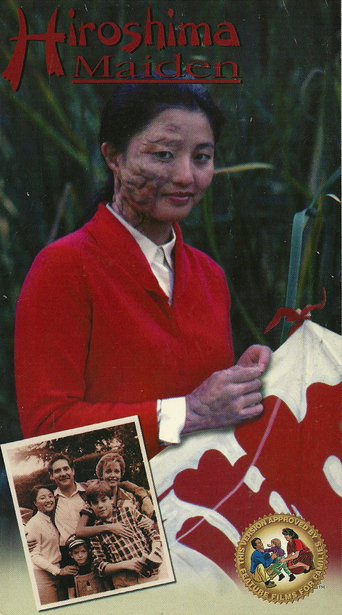Gutsycurene
Fanciful, disturbing, and wildly original, it announces the arrival of a fresh, bold voice in American cinema.
tavm
In 1955, an American family takes in a female teenage survivor of Hiroshima. Of the two male children, the adolescent older one is hesitant at first to greet her especially having previously played war games with his treehouse friends with the Japanese, whom they referred to as Japs, as the enemy. Johnny, the older son, tries to satisfy the curiously of himself and his friends by switching light off to see if Miyeko, the Hiroshima girl, glows in the dark, and attempts to take a picture of her to show them. Miyeko shows Johnny her pre-Hiroshima pic and her paper birds that she wants to make thousands of to remind people of the children of Hiroshima. Miyeko is in America for surgery of her half-burned face she suffered during bombing. Because this is a family drama with only a running time of 58 minutes, the prejudices that result with Miyeko's arrival is subtle but effective. Some goes for the performances though Richard Masur (Johnny's dad Jim Bennett) and Dennis Haskins (bigoted neighbor Hal Latimer) have an almost intense scene near the end. A previous reviewer mentioned what some of the players have done since this film, so I'll say that Stephen Dorff (Johnny) has recently been in Oliver Stone's World Trade Center and Haskins shortly after this became better known as Principal Belding in "Good Morning, Miss Bliss" and "Saved by the Bell". And Tamyln Tomita (Miyeko) was in The Day after Tomorrow. I bought a DVD of Hiroshima Maiden at a church fair for $1 last Sunday because the subject matter interested me. Recommended for anyone interested in World War II history and its aftermath.
ghost1-2
After viewing The Hiroshima Maiden, one walks away with the feeling that the movie was actually designed to be a documentary of people's reaction to a foreign idea, rather than a movie produced simply for entertainment value, because of the loose plot.Directed by Joan Darling, who also directed the popular television shows "M*A*S*H" and "The Mary Tyler Moore Show", the movie does an excellent job in making the viewer feel like they are at home with the main family. She shows their pouts, their disputes, and even scenes of love and bonding.While the movie consists of cast members who are early in their career, they all pull together to present an average American family. Susan Blakely went on to perform in this year's movie The Perfect Nanny. Stephen Dorff continued his acting career and landed a spot in the 1998 hit movie, Blade. Richard Masur chose his career path to lead to two comedy hits, Encino Man, in 1992 and Multiplicity in 1996, and Tamlyn Tomita, who previously starred in The Karate Kid, Part II, later grabbed a role in the `Babylon 5' television series.Movies always leave impressions with their audience; The Green Mile left you feeling sad, while The Abyiss left you feeling like something actually was out there. This movie is no exception, but unlike others, left four impressions.A play on the viewer's emotions was the first impression this critic saw. The movie relied heavily on individual scenes where people would show their true feelings to evoke emotion from the audience. Mieko, the girl who stays with the American family, sits in her room looking at childhood pictures, and Johnny, the older son of the host family, feels sorry for himself after he takes one of Mieko's letters. Scenes of the younger child in the family playing with Mieko also apply to this impression.The second impression this critic was left with was that the movie was meant to be an educational tool, a reminder of the dropping of the bomb in Hiroshima, and how we must never forget. During a midnight meeting with Mieko, Johnny asks what the bombing was like, because `Nobody ever talks about it'. This statement here proves that more is needed to be done to educate younger generations of their history because if a subject becomes taboo, it eventually becomes forgotten.The third impression left was that the movie was supposed to show the cultural differences between the Japanese and the Americans. Constantly, the movie showed Mieko enjoying herself, and then the American families enjoying themselves. Through camera changes such as these, a contrast between the two cultures is brought out.The last impression that this critic received was that the movie tried to show how racism can be brought down to the common family. Near the end, the father of one of Johnny's friends came over to the house, and said something along the lines of, "and it's not just me, it's the whole neighborhood", referencing the wish for Mieko to leave.If you are going to see Hiroshima Maiden for the first time, you have to be prepared for it. It is not an entertaining movie, nor does leave viewers with the feeling that it was meant to be one. Instead, see the movie expecting to watch reactions of 80's Americans. See the movie expecting children reacting with their parents views. See the movie, expecting...The Hiroshima Maiden.

